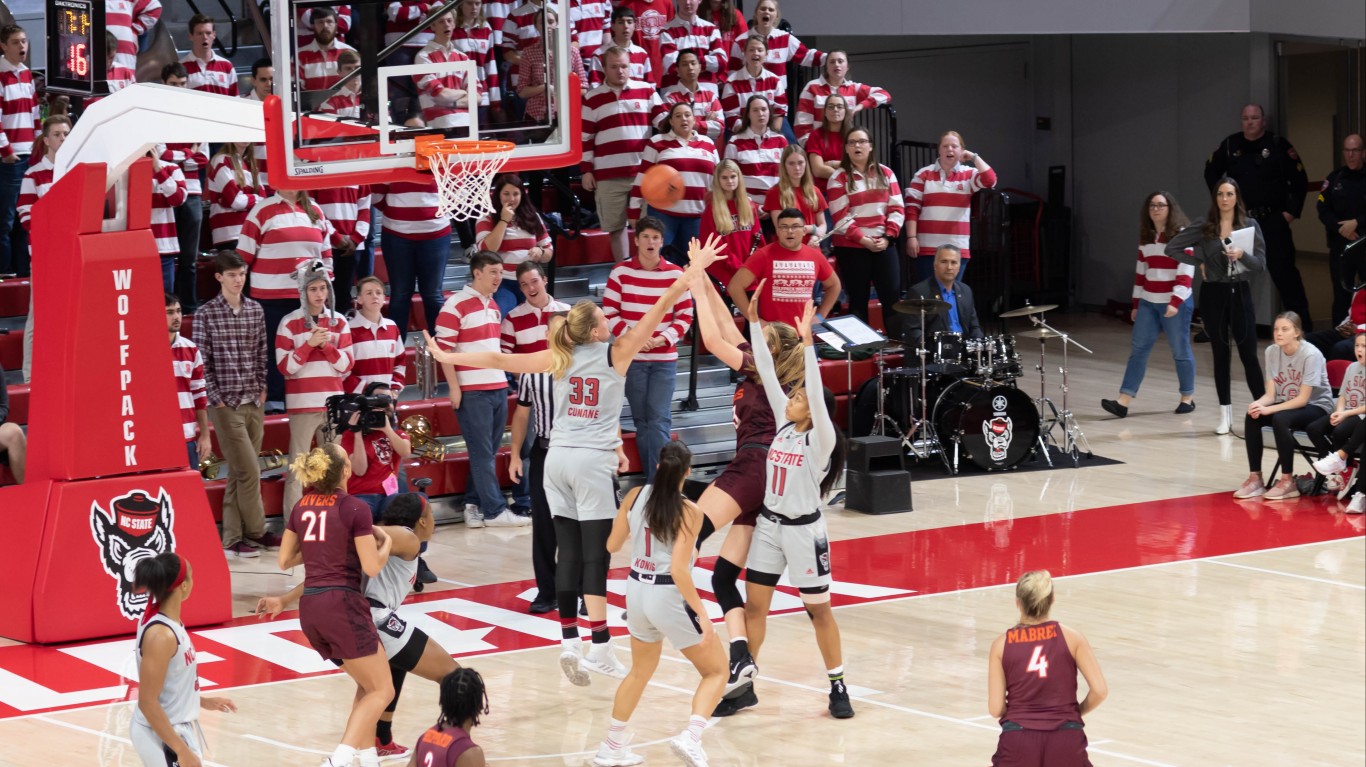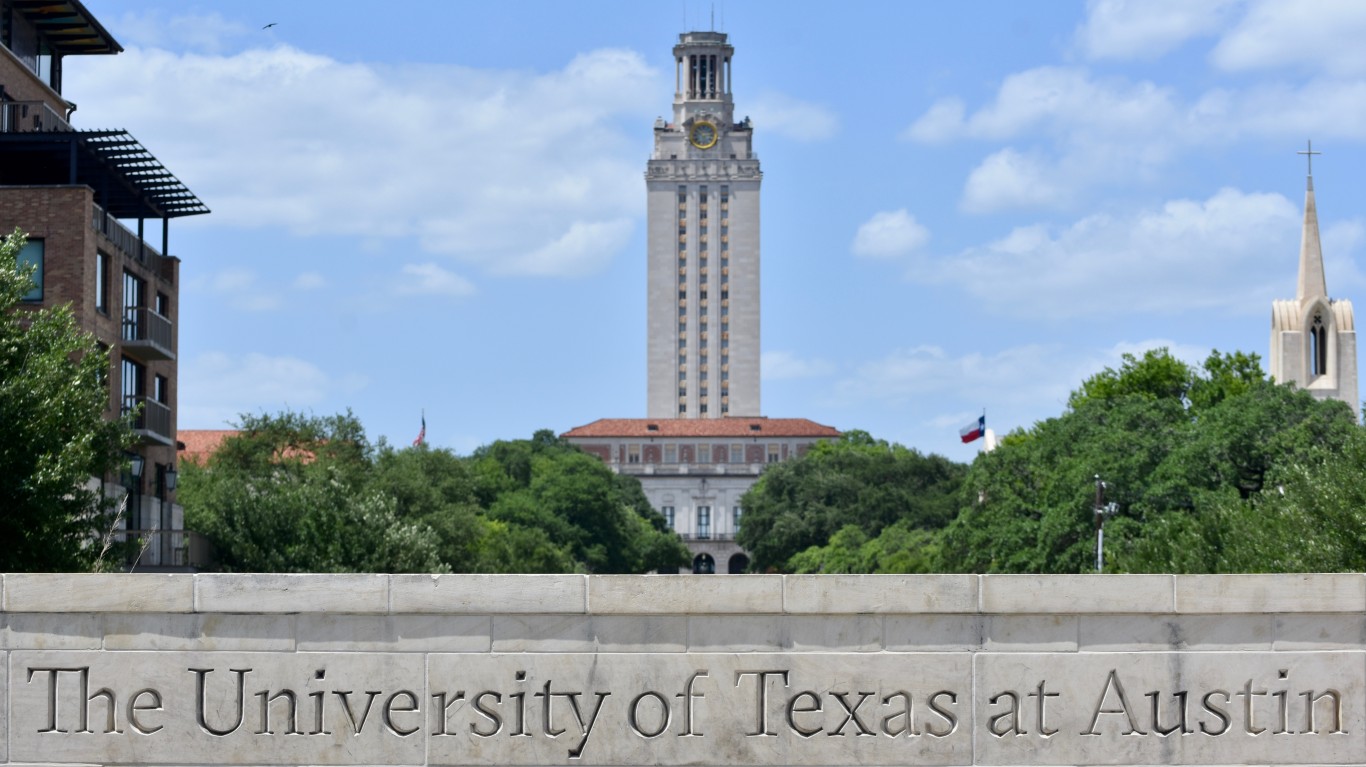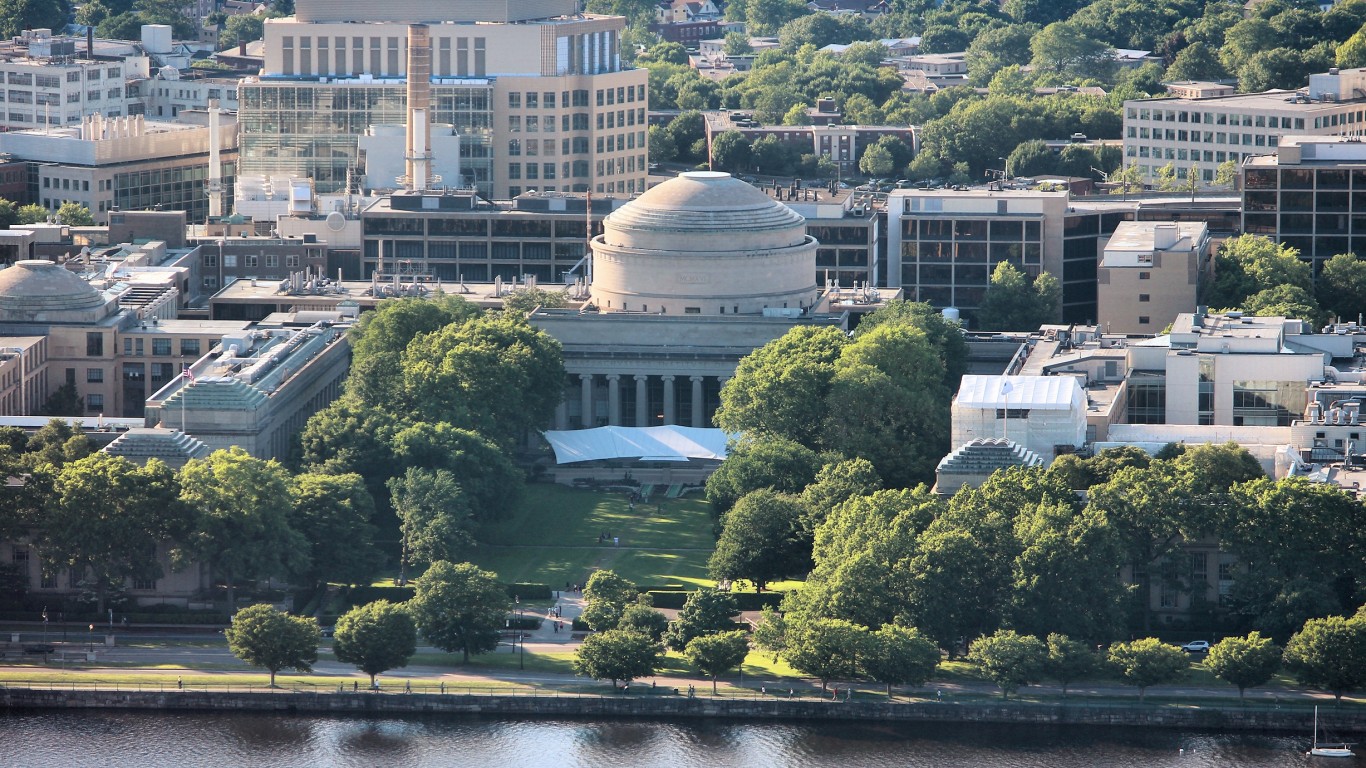
A college education can set students up for a lifetime of professional success. But the reality is that getting into a good school is difficult, as many top tier schools are highly selective and prohibitively expensive.
Yet there are a number of publicly-funded schools that offer high-quality education that are more affordable and more accessible than smaller, private schools. These schools are located across the country, and in almost every case are less expensive than the typical private school.
To determine the top public universities in America, 24/7 Wall St. reviewed data on academics, admissions, finance, and student life from school data platform Niche. We reviewed schools with a grade of A+ in Niche’s 2021 Top Public Universities in America report.
The 31 public universities with A+ grades from Niche are spread across 18 states — six are in California, three are in Virginia, while Pennsylvania, Texas, Michigan, North Carolina, and Florida are home to two apiece.
Part of the reason these schools rank so highly is that their students go on to be relatively financially successful, earning high incomes and reporting low unemployment rates. Though this may be at least partly due to large alumni networks and high-quality education, some of the alumni’s success is due to the fact that these schools tend to award a large share of degrees in fields that can translate into high-income careers, like business and engineering. These are the college majors that pay off the most.
Click here to see America’s top public universities.
Click here to read our detailed methodology.

31. Michigan State University
> Location: East Lansing, MI
> Undergraduate enrollment: 39,176
> Avg. net price: $16,579
> Admission rate: 71.1%
> Avg. earnings 10 years after entry: $63,200
Michigan State University ranks as one of the top public universities in America. It is one of just 31 state schools to receive an A+ grade from school data platform Niche for 2021. Niche ranked schools based on their academics, overall value, professors, student life, and several other factors.
Michigan State received an A for its academics — more than 80% of undergraduate students go on to finish their degree, compared to less than 50% of students nationwide. MSU professors received an A+ grade based on their accomplishments, salary, and student reviews. The vast majority of students at Michigan State say their professors are passionate, engaging, and approachable and helpful when needed.
[in-text-ad]
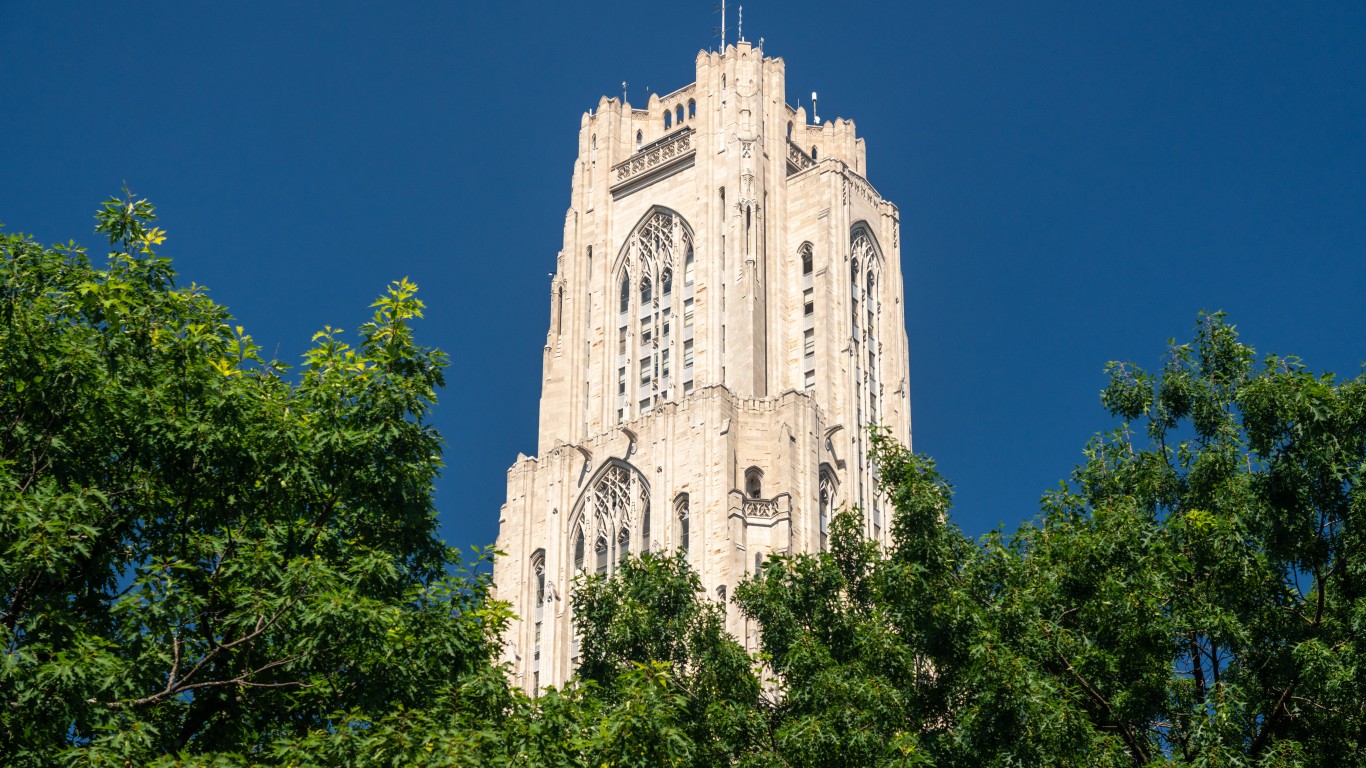
30. University of Pittsburgh
> Location: Pittsburgh, PA
> Undergraduate enrollment: 23,385
> Avg. net price: $22,600
> Admission rate: 56.7%
> Avg. earnings 10 years after entry: $61,200
Though public schools tend to be less expensive than private ones, the University of Pittsburgh is relatively pricey. The school’s average net price of $22,600 is higher than the $19,220 average price for private schools, and more than double the $9,915 average for public colleges.
However, the University of Pittsburgh seems to still be a good value, as the average student earns over $61,000 per year a decade after entering the school, well above the vast majority of other public colleges. Most of the over 300 public colleges for which there is data report that their former students earn less than $52,000 per year a decade after entering the school.
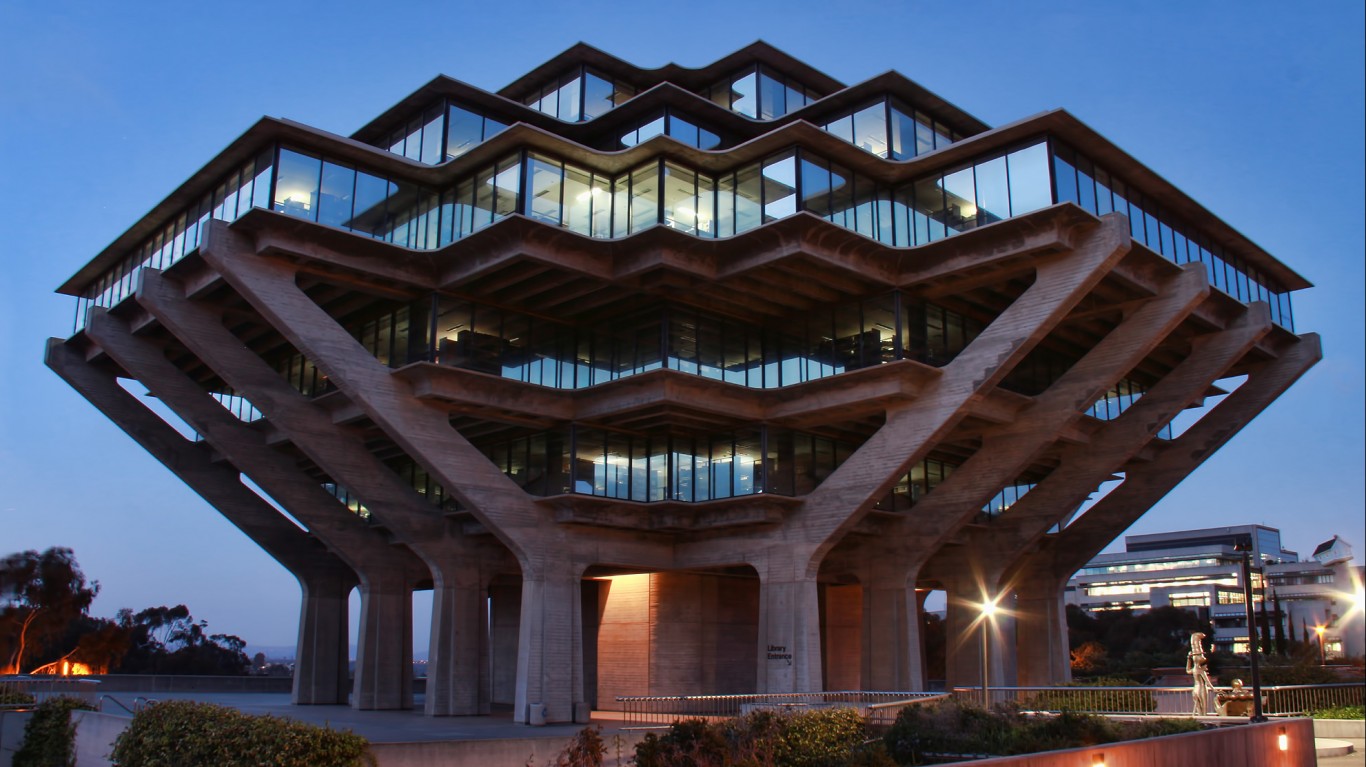
29. University of California – San Diego
> Location: La Jolla, CA
> Undergraduate enrollment: 30,794
> Avg. net price: $14,864
> Admission rate: 31.5%
> Avg. earnings 10 years after entry: $69,600
University of California – San Diego is one of six schools that are part of the University of California System to rank among the top public universities. UCSD received A+ grades from Niche for its academics and its value. Though its average net price of under $15,000 is lower than most other top public colleges, UCSD students have an average income of nearly $70,000 10 years after first attending school, among the highest average incomes for public colleges.
University of California – San Diego students have a graduation rate of 87%, well beyond the 49% rate nationwide. According to the Niche survey, three-quarters of students said that UCSD professors care about the success of their students, and more than 80% said that professors are passionate about the topics they teach.

28. University of Maryland – College Park
> Location: College Park, MD
> Undergraduate enrollment: 30,511
> Avg. net price: $17,723
> Admission rate: 44.2%
> Avg. earnings 10 years after entry: $70,800
Given their large student bodies, public schools are typically easier to get into than smaller and more selective private schools. However, this is not the case at University of Maryland – College Park as the school accepts just 44.2% of applicants. The school’s students have a median combined SAT score of 1380, which is one of the 10 highest among all U.S. public schools.
Students who graduated from University of Maryland – College Park earn on average $70,800 a year a decade after entering the school, one of the top 20 average incomes among U.S. public schools.
[in-text-ad-2]

27. University of California – Davis
> Location: Davis, CA
> Undergraduate enrollment: 30,982
> Avg. net price: $15,886
> Admission rate: 38.9%
> Avg. earnings 10 years after entry: $68,100
The University of California – Davis ranks as one of America’s best public universities, receiving high marks from Niche for its value, academics, and campus. With an admission rate below 40%, UCD students tend to have relatively high SAT scores.
Like many other schools on this list, the most commonly awarded degree at the University of California – Davis is in a STEM field, specifically biological and biomedical sciences. These fields tend to set up graduates for high-paying jobs, which holds true in the case of UCD. A decade after entering the school, students average an income over $68,000, one of the highest averages among public schools.

26. University of California – Irvine
> Location: Irvine, CA
> Undergraduate enrollment: 30,382
> Avg. net price: $15,268
> Admission rate: 26.5%
> Avg. earnings 10 years after entry: $65,800
University of California – Irvine ranks as one of the top public schools in the nation in part because it is also one of the most selective. With an admission rate of just 26.5%, the school can admit students who have proven they can excel in an academic setting. The typical admission rate across all colleges is more than twice as high, at 56.7%.
Niche ranks UC Irvine as one of the top public schools in large part because of its top-rated faculty. The school attracts professors by paying relatively high salaries. The average salary of professors at the school is over $145,000 annually, one of the five highest among public schools, and more than double the nationwide average salary for a professor of $62,657.
[in-text-ad]
25. Clemson University
> Location: Clemson, SC
> Undergraduate enrollment: 20,195
> Avg. net price: $21,482
> Admission rate: 51.3%
> Avg. earnings 10 years after entry: $58,900
Though Clemson University has been renowned for its football team in recent years, thanks to its academics, value, campus, and more, it also ranks as one of America’s top public universities, according to Niche.
Most of the degrees the South Carolina college awards are either in engineering, business, and or biological and biomedical sciences — all of which can help set up students for success. Just 7.5% of students are unemployed a decade after entry, one of the lowest jobless rates among all public schools.
24. University of Minnesota Twin Cities
> Location: Minneapolis, MN
> Undergraduate enrollment: 35,165
> Avg. net price: $17,279
> Admission rate: 56.7%
> Avg. earnings 10 years after entry: $61,200
The University of Minnesota Twin Cities is one of the top public schools in the country. The school received either A or A+ grades from Niche for its academics, athletics, diversity, and value.
Per a Niche survey of current and former students, more than three-quarters of University of Minnesota Twin Cities alumni said they felt that the professors are helpful, approachable, invested in the success of their students and are passionate about the topics they teach

23. Florida State University
> Location: Tallahassee, FL
> Undergraduate enrollment: 33,270
> Avg. net price: $12,568
> Admission rate: 36.0%
> Avg. earnings 10 years after entry: $53,900
Florida State University ranks as one of America’s top public universities because it ranks among the schools with the best value. The school provides a high quality education for an average net price of $12,568 — lower than nearly every other school on this list — in large part because 96% of all undergraduates receive some kind of financial aid, the highest percentage of any public school in the nation.
Florida State is one of the largest schools in the country, with over 33,000 undergraduates, 90% of whom hail from the state of Florida. This results in a fairly high student-to-faculty ratio of 21:1. High ratios such as this can be an impediment to learning, as many students need more individualized attention. Only about half of students say they took advantage of office hours or study sessions.
[in-text-ad-2]
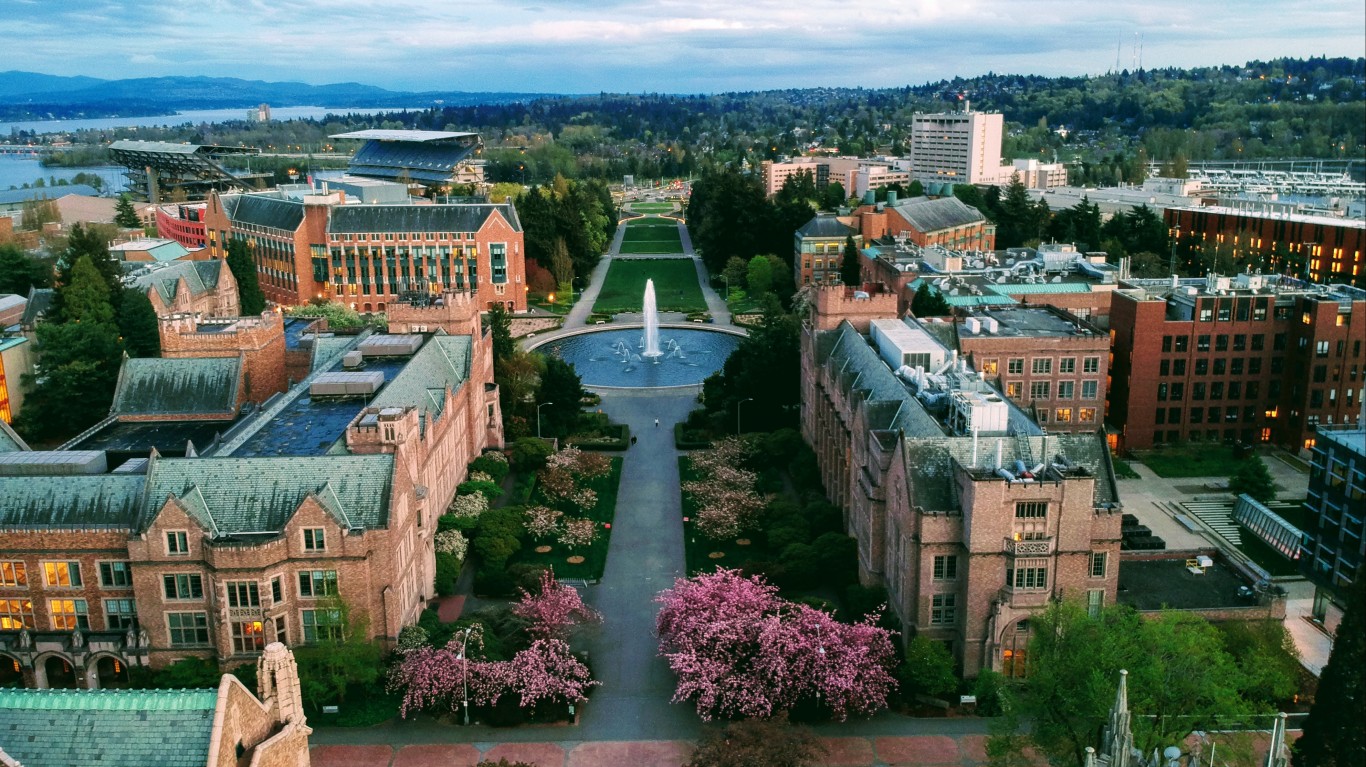
22. University of Washington
> Location: Seattle, WA
> Undergraduate enrollment: 32,046
> Avg. net price: $10,692
> Admission rate: 51.8%
> Avg. earnings 10 years after entry: $69,600
The University of Washington is one of just three top public universities with an average net price below $11,000. The school received an A grade from Niche for its value because Washington students tend to be financially well off after graduating, representing a considerable return on the price of their education. A decade after entering the school, attendees reported an average earnings of nearly $70,000 per year.
As one of the top public schools in the country, the University of Washington attracts many students, including those from outside the state. Of the school’s 32,000 undergraduate students, 38% pay out-of-state tuition, well beyond the 9% of out-of-state students at the typical public college.
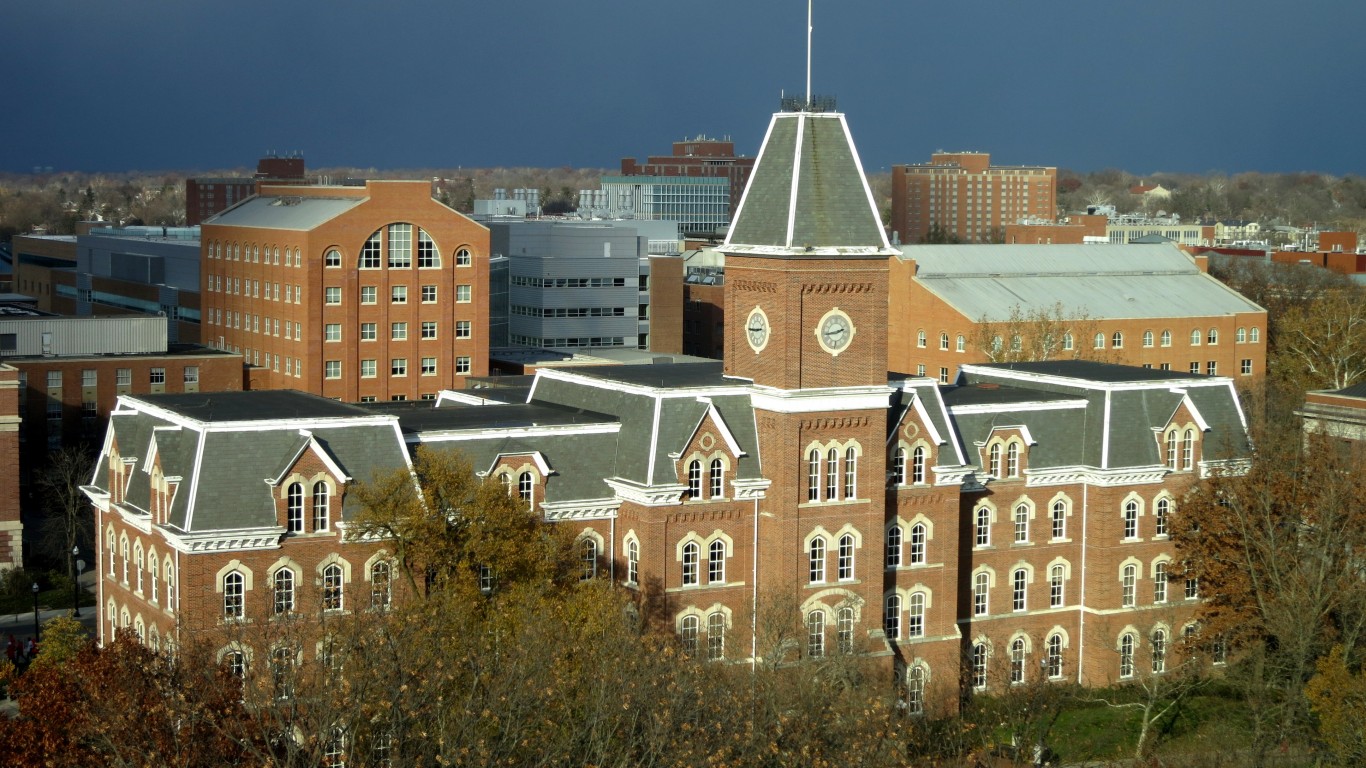
21. The Ohio State University
> Location: Columbus, OH
> Undergraduate enrollment: 46,818
> Avg. net price: $18,706
> Admission rate: 53.7%
> Avg. earnings 10 years after entry: $53,600
The Ohio State University is the fifth-largest school in the country, with an undergraduate enrollment of nearly 47,000. The school received an overall A+ grade from Niche, with A grades for its campus, academics, and value.
Though The Ohio State University ranks among the top public colleges, its former students rank behind those of other schools on this list in one key measure. A decade after entering the college, a former student’s average earnings is just $53,600 — the lowest of any school on this list and towards the middle of all public schools in the U.S.
[in-text-ad]
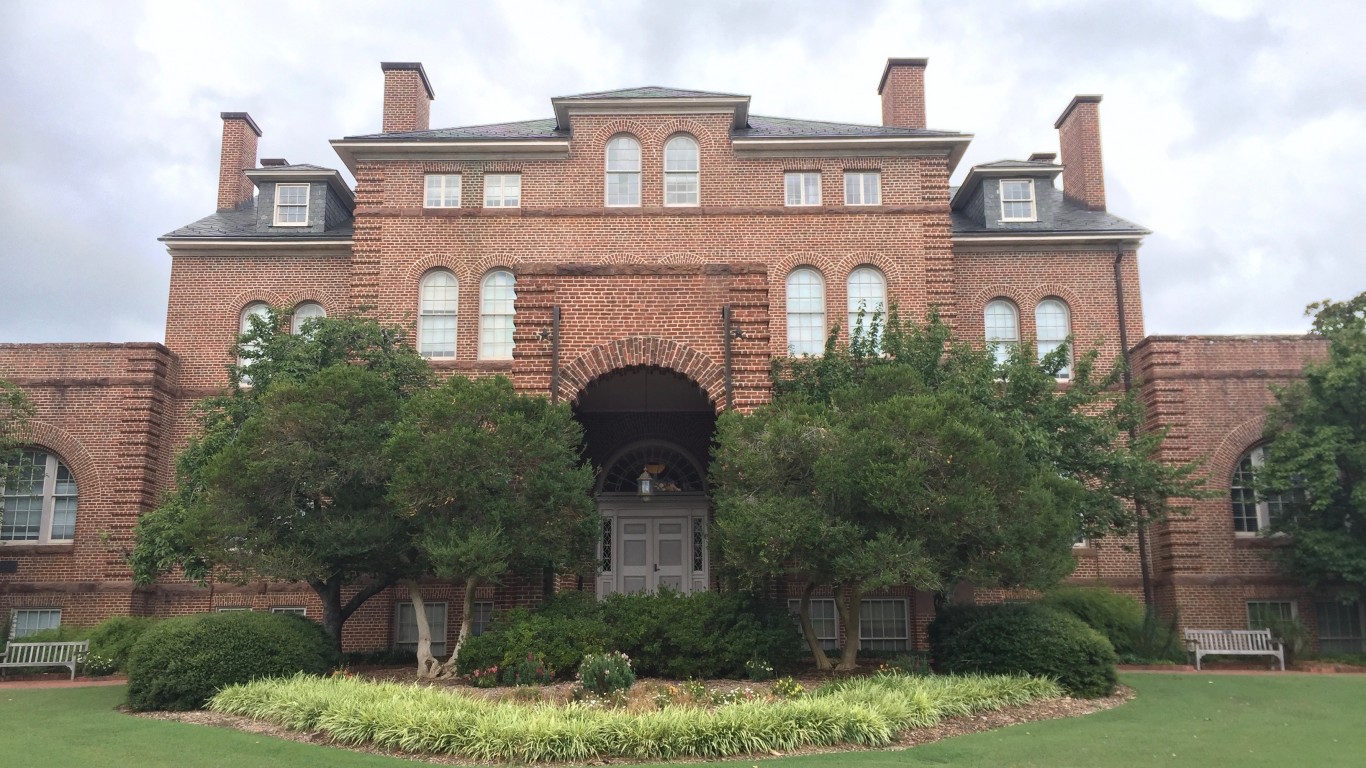
20. North Carolina State University
> Location: Raleigh, NC
> Undergraduate enrollment: 25,973
> Avg. net price: $14,958
> Admission rate: 45.1%
> Avg. earnings 10 years after entry: $59,500
North Carolina State ranks as one of America’s top public universities in part because it received an A+ grade from Niche for its value. Though it boasts highly-rated academics and professors, it is one of the least expensive schools on this list, with an average net price under $15,000.
North Carolina State University makes up one corner of the state’s famed Research Triangle, with Duke University, and University of North Carolina at Chapel Hill completing the other two corners. As a result, the area is full of science, tech, and engineering jobs. A decade after entering NC State, former students earn an average income of $59,500 and have an unemployment rate of 8.1% — both of which rank better than the vast majority of other public schools.

19. University of California – Santa Barbara
> Location: Santa Barbara, CA
> Undergraduate enrollment: 23,349
> Avg. net price: $16,767
> Admission rate: 29.6%
> Avg. earnings 10 years after entry: $62,400
Located in the most populous state, many of the schools in the University of California System, including UC Santa Barbara, received close to 100,000 applications for the 2019-20 school year. As one of the top public universities in the nation, UC Santa Barbara was very selective, admitting less than 30% of applicants.
The professors and academics at UC Santa Barbara received high marks from Niche. The school is able to attract top-tier professors in part because of its finances. It is one of just three public universities at which the average professor earns over $150,000 per year.
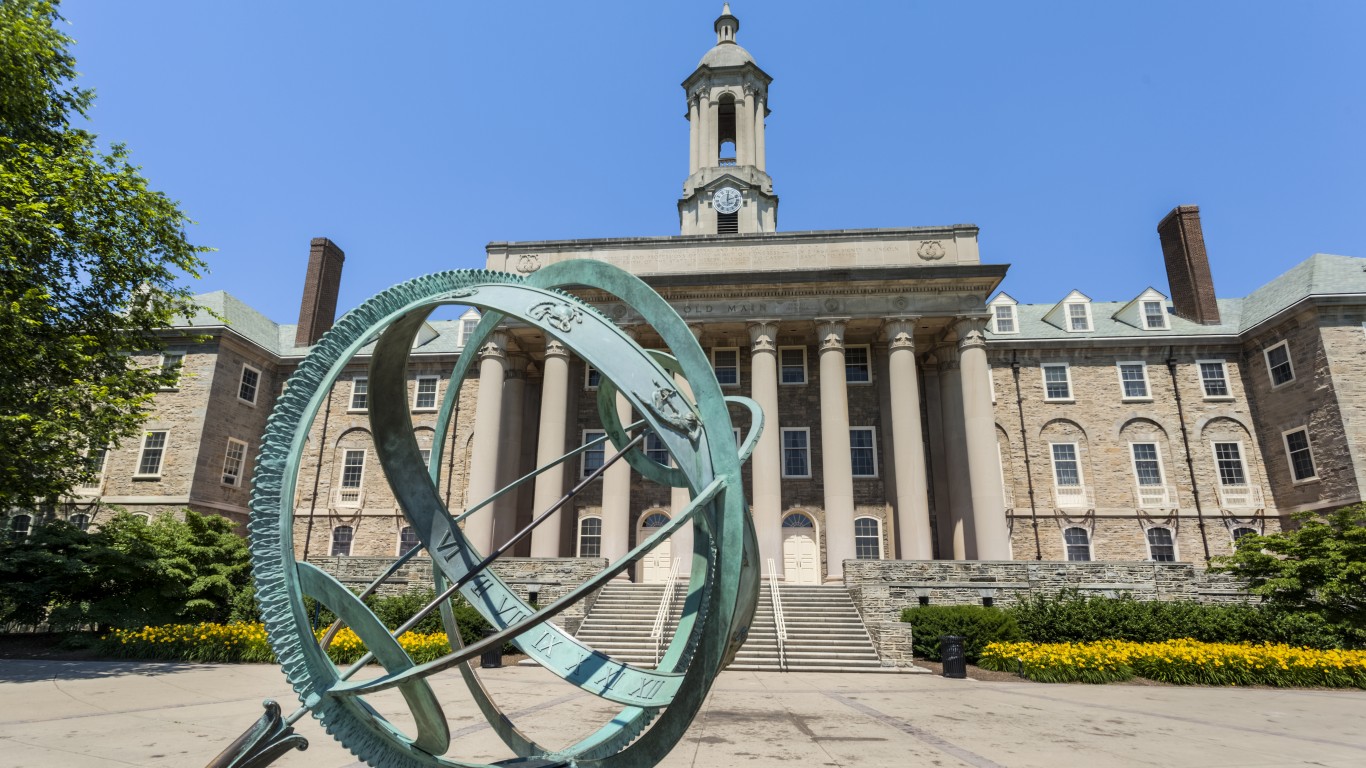
18. Penn State
> Location: University Park, PA
> Undergraduate enrollment: 76,099
> Avg. net price: $24,724
> Admission rate: 75.9%
> Avg. earnings 10 years after entry: $57,200
With more than 76,000 undergraduate students, Penn State is by far the largest college in America. No other school has even 60,000 students. Among public schools, it is one of the most expensive, with an average net price of nearly $25,000. This is more than double the average net price of the typical public college of $9,915. The average student received under $7,000 of financial aid, by far the lowest of schools on this list.
One drawback that often comes with being at a large public school is large class sizes that can make it hard for students to get individualized attention. However, Penn State’s 15:1 student-to-teacher ratio is in line with other public colleges across the country. The school ranks as one of the best public schools in the country due largely to its professors, who received an overall A+ grade on Niche.
[in-text-ad-2]
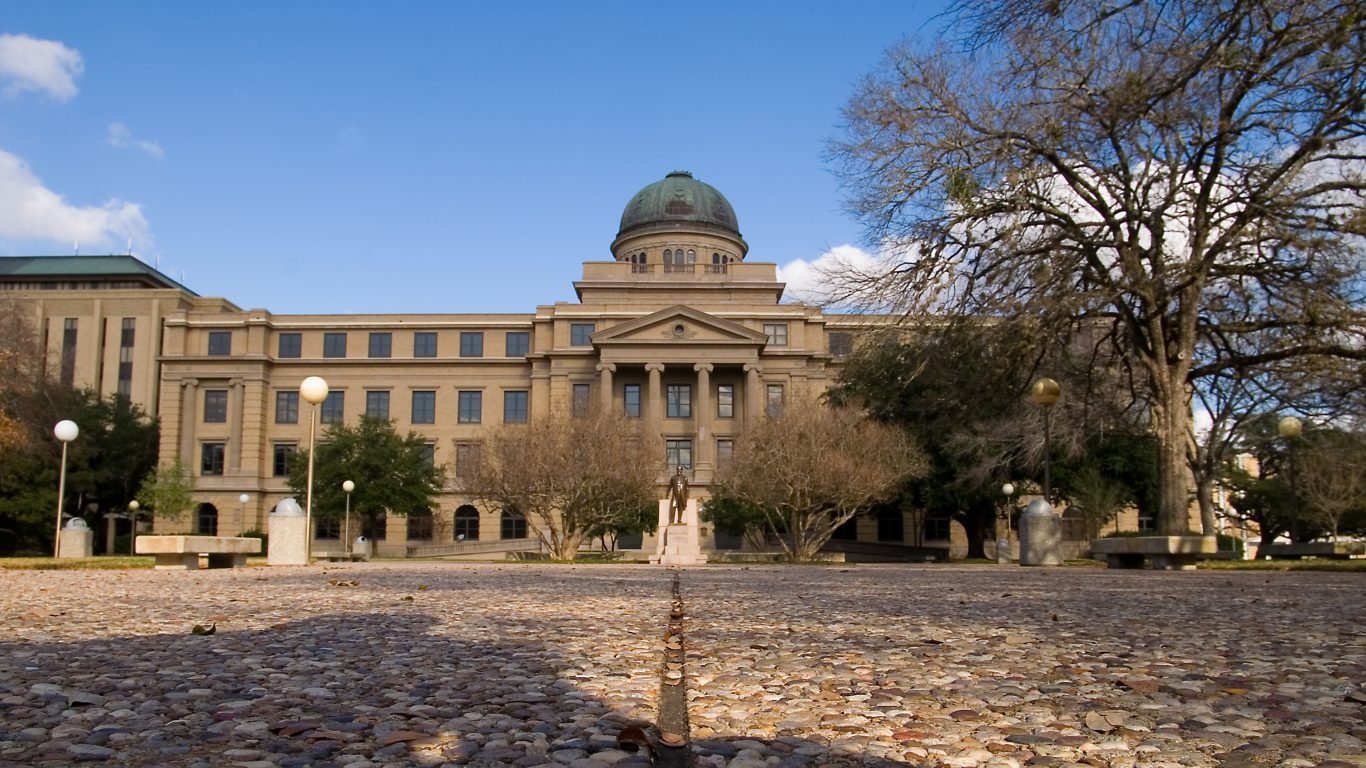
17. Texas A&M University
> Location: College Station, TX
> Undergraduate enrollment: 53,791
> Avg. net price: $19,237
> Admission rate: 57.8%
> Avg. earnings 10 years after entry: $67,800
Texas A&M University is one of the largest and most prestigious public universities in the country. It has more than 53,000 undergraduate students, third most in the nation. Though its net price is higher than that of the typical public college, Texas A&M received an A+ score for its value from Niche as students typically go on to earn relatively high wages after leaving the school.
The vast majority of Texas A&M’s students hail from the Lone Star State — 94% of students pay in-state tuition rates, by far the highest of any school on this list. This may be due in part to the fact that the state of Texas has a rule guaranteeing admission to any state-funded college to high school students who finish in the top 10% of their graduating class.
16. Colorado School of Mines
> Location: Golden, CO
> Undergraduate enrollment: 5,156
> Avg. net price: $26,856
> Admission rate: 53.1%
> Avg. earnings 10 years after entry: $95,600
Colorado School of Mines stands out on this list for a number of reasons. Its average net price of $26,856 is the highest of any public college in America. Also, of the top 31 public colleges according to Niche, the average earnings of former students a decade after entry is by far the highest, at $95,600.
With just over 5,000 students, Colorado School of Mines is one of the smallest public colleges to rank among the best in the nation. Seven of eight degrees the school awards are engineering degrees. With gold and silver mines nearby, the school was founded in Golden, Colorado, with the goal to teach students higher education about mining.
[in-text-ad]
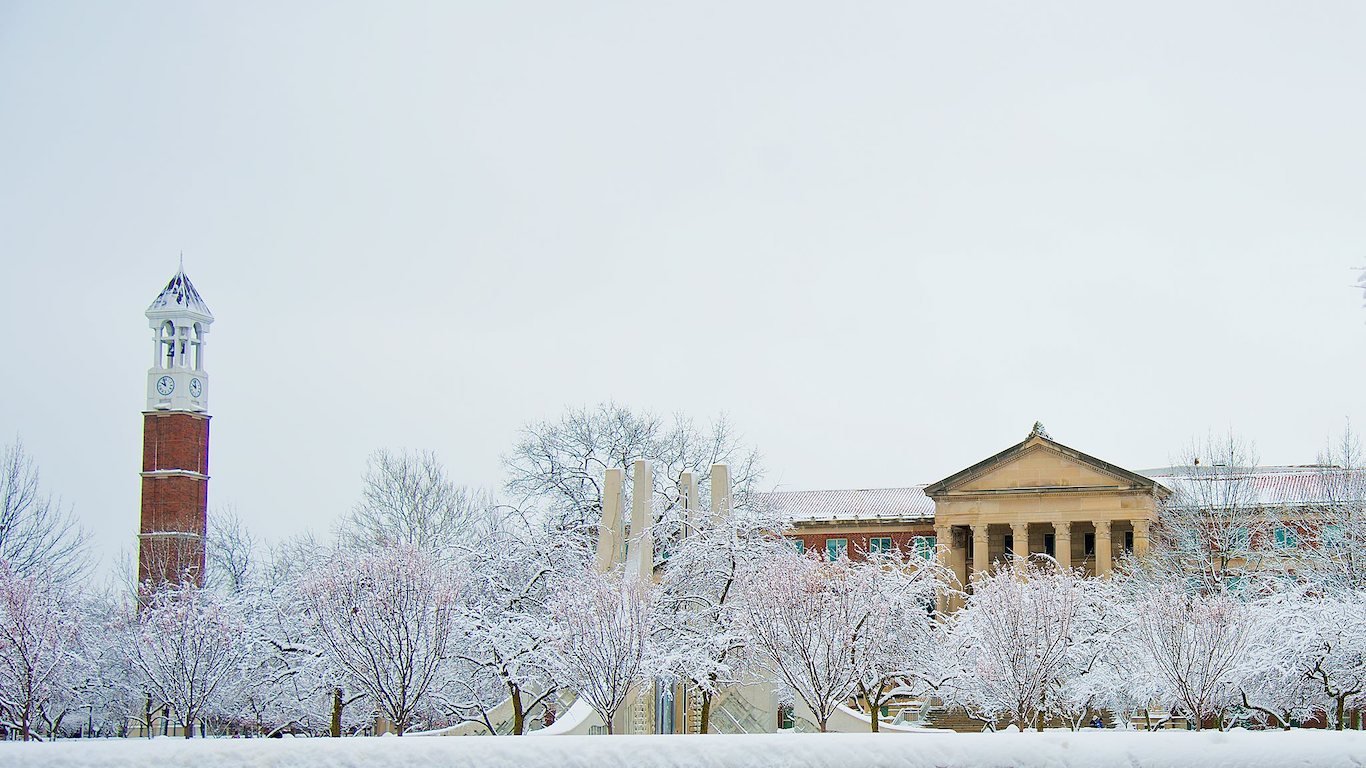
15. Purdue University
> Location: West Lafayette, IN
> Undergraduate enrollment: 34,596
> Avg. net price: $12,684
> Admission rate: 59.8%
> Avg. earnings 10 years after entry: $62,200
Purdue University in West Lafayette, Indiana, is known as one of the top public universities in America, particularly for students studying engineering. More than one in five graduates receive an engineering degree, though business and computer science majors are also popular.
Students can sometimes struggle to get individualized attention at public schools because of the large class sizes. Yet at Purdue, the student-to-faculty ratio is 13:1, one of the lowest on this list and under the 15:1 ratio at the typical public school. This gives students a better chance to ask questions, get feedback, and build a community with their classmates. This may be part of the reason Purdue’s professors received an A+ rating from Niche.

14. University of Illinois at Urbana-Champaign
> Location: Champaign, IL
> Undergraduate enrollment: 34,120
> Avg. net price: $14,660
> Admission rate: 59.0%
> Avg. earnings 10 years after entry: $70,900
The University of Illinois at Urbana-Champaign is one of just 20 public schools at which the average former student earns over $70,000 per year 10 years after entering the school. With such a high average income and an average price of attendance lower than most other public schools at $14,660, the university received an A+ grade for its value from Niche.
The University of Illinois at Urbana-Champaign’s academics and professors both received top marks as well. The school’s graduation rate of 85% is much higher than the 49% rate at the typical college. The school has a number of research institutes and $13,755 in research funding per student, compared to just over $1,500 at the typical college.
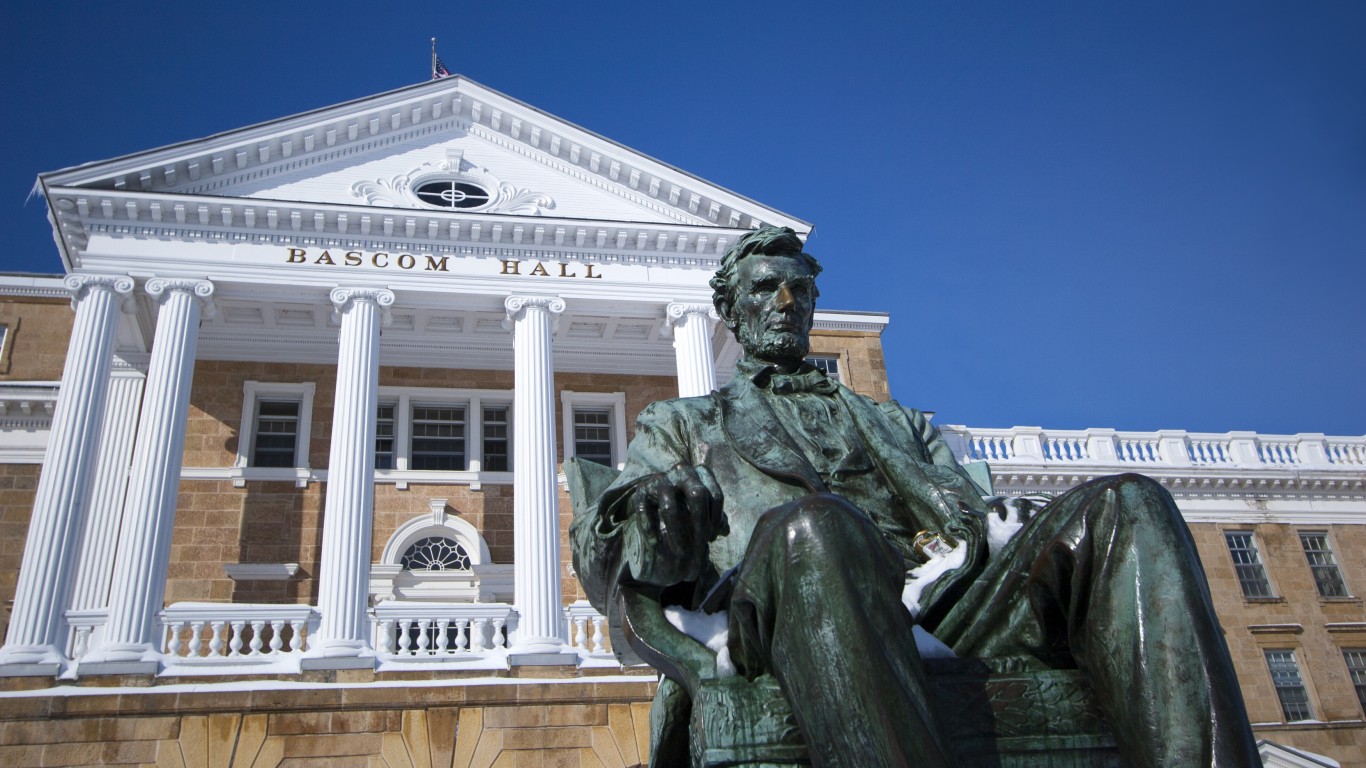
13. University of Wisconsin
> Location: Madison, WI
> Undergraduate enrollment: 32,399
> Avg. net price: $16,103
> Admission rate: 54.4%
> Avg. earnings 10 years after entry: $68,000
The University of Wisconsin ranks as one of the top public schools in the country as it accepts only top students and equips them for professional success. UW students have a median combined SAT score of 1365, the 12th highest of all public colleges. A decade after leaving the school, just 6.6% of students are unemployed and they have an average earnings of $68,000 — both rank among the best in the nation for public colleges.
Beyond education, University of Wisconsin offers students a high quality of life while they attend the school. University of Wisconsin ranks among one of the three top colleges — public or private — with the best student life in the country, according to Niche.
[in-text-ad-2]
12. Virginia Tech
> Location: Blacksburg, VA
> Undergraduate enrollment: 29,300
> Avg. net price: $18,449
> Admission rate: 70.0%
> Avg. earnings 10 years after entry: $67,100
Virginia Tech in Blacksburg ranks among the top colleges with students fairly successful after leaving. A decade after entering Virginia Tech, former students’ average earnings exceed $67,000, higher than the vast majority of other public schools. Virginia Tech alumni also have the lowest unemployment rate a decade after entering, at 6.2%.
One of Virginia Tech’s many strengths is its professors. The faculty as a whole received an A+ grade from Niche based on factors like their accomplishments and student surveys. For instance, 89% of students said ther professors were passionate, 87% said their professors were approachable and helpful, and 85% said professors care about their students’ success.
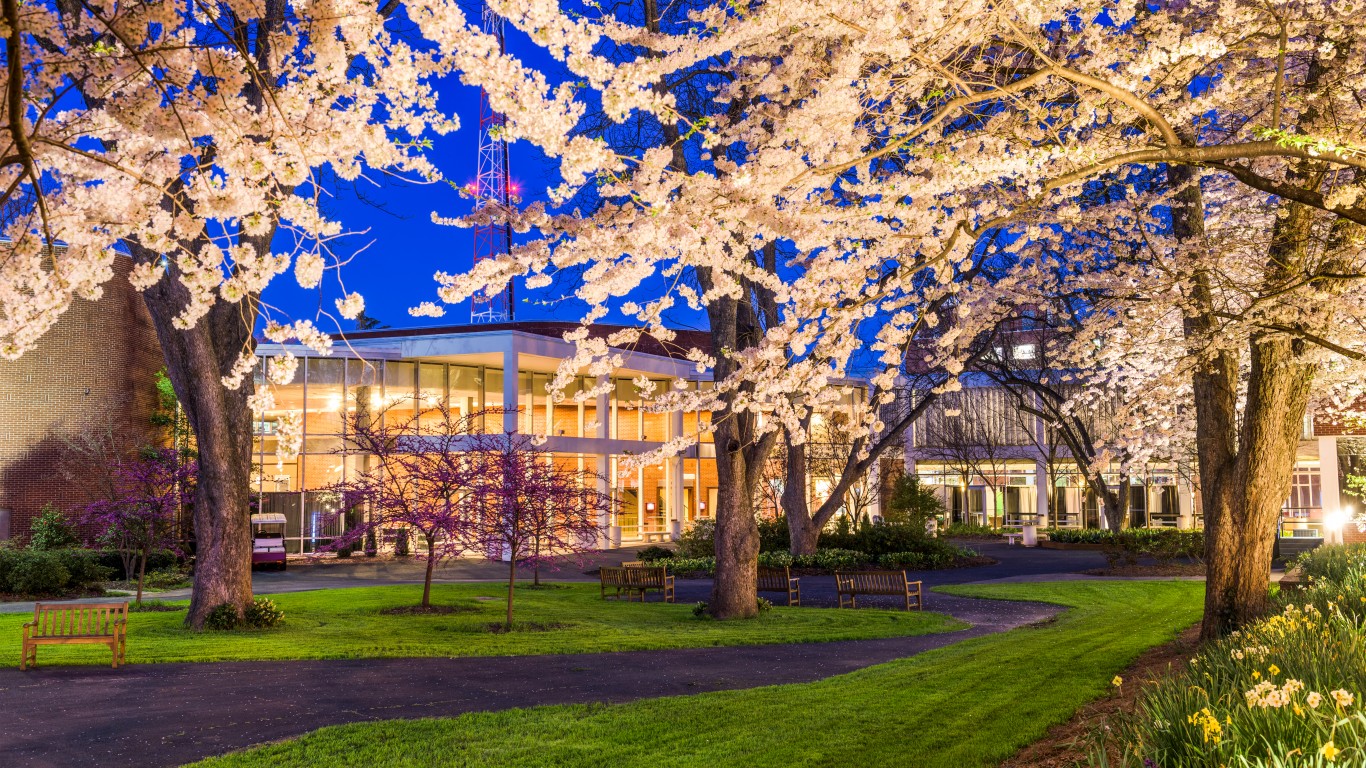
11. University of Georgia
> Location: Athens, GA
> Undergraduate enrollment: 29,848
> Avg. net price: $15,961
> Admission rate: 45.3%
> Avg. earnings 10 years after entry: $59,100
The University of Georgia received high marks from Niche for its academics, campus, and its value as 86% of its nearly 30,000 students received some kind of financial aid, one of the 10 highest shares among public schools. Such aid helps defray costs and push the average net price below $16,000.
Like many other top public colleges, the University of Georgia awards more business degrees than degrees in any other field. More than 27% of UGA graduates get a business degree. Other popular majors include communications, journalism, and social sciences.
[in-text-ad]
10. University of Texas – Austin
> Location: Austin, TX
> Undergraduate enrollment: 40,163
> Avg. net price: $15,502
> Admission rate: 31.8%
> Avg. earnings 10 years after entry: $73,900
The University of Texas – Austin is one of the 10 largest schools in the nation, with an undergraduate enrollment of more than 40,000. Despite being a large college, it admits less than a third of applicants, and this selectivity helps boost the quality of students at the school and pushes UT into the top 10 public universities in America.
UT’s McCombs School of Business is widely recognized as one of the best business schools in America, and almost 19% of all University of Texas graduates receive a degree in business, management, marketing, and related support services.
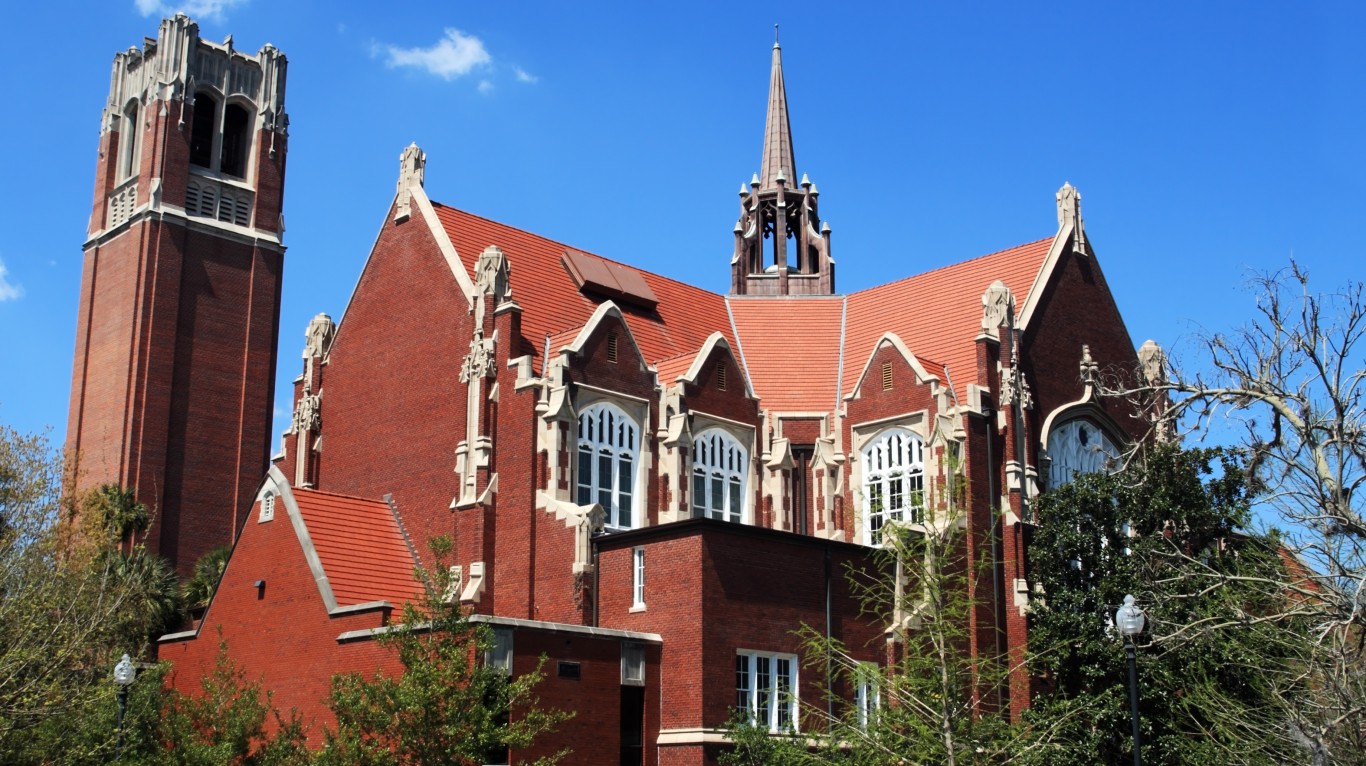
9. University of Florida
> Location: Gainesville, FL
> Undergraduate enrollment: 35,405
> Avg. net price: $10,457
> Admission rate: 36.6%
> Avg. earnings 10 years after entry: $65,700
The University of Florida ranks among America’s 10 best public universities in part because Niche ranks it as one of the best value schools. In addition to a relatively low average net price of less than $10,500 per year, former students average an income of over $65,000 per year 10 years after entering the Gainesville college, one of the higher average earnings.
Florida received an A+ grade for its academics, as it retains 97% of full-time students and boasts an 88% graduation rate, well above the nationwide graduation rate of less than 50%. Its professors as a whole received an A+ grade as well.

8. William & Mary
> Location: Williamsburg, VA
> Undergraduate enrollment: 6,256
> Avg. net price: $18,551
> Admission rate: 37.7%
> Avg. earnings 10 years after entry: $74,500
William & Mary is the second oldest college in America, predating the United States itself, having been founded in 1693. Only Harvard University is older. More than three centuries later, it still ranks among the nation’s best higher learning institutions. The school selects only top candidates for entry, admitting fewer than 38% of applicants. It is one of just six public schools at which students have a median combined SAT score of 1400 or higher.
William & Mary benefit from more individualized attention than the students of almost every other major public school. Its 11:1 student-to-faculty ratio allows for close-knit student communities and a chance to take a more hands-on approach to their education. At the typical public school, the student-to-faculty ratio is much higher at 15:1.
[in-text-ad-2]
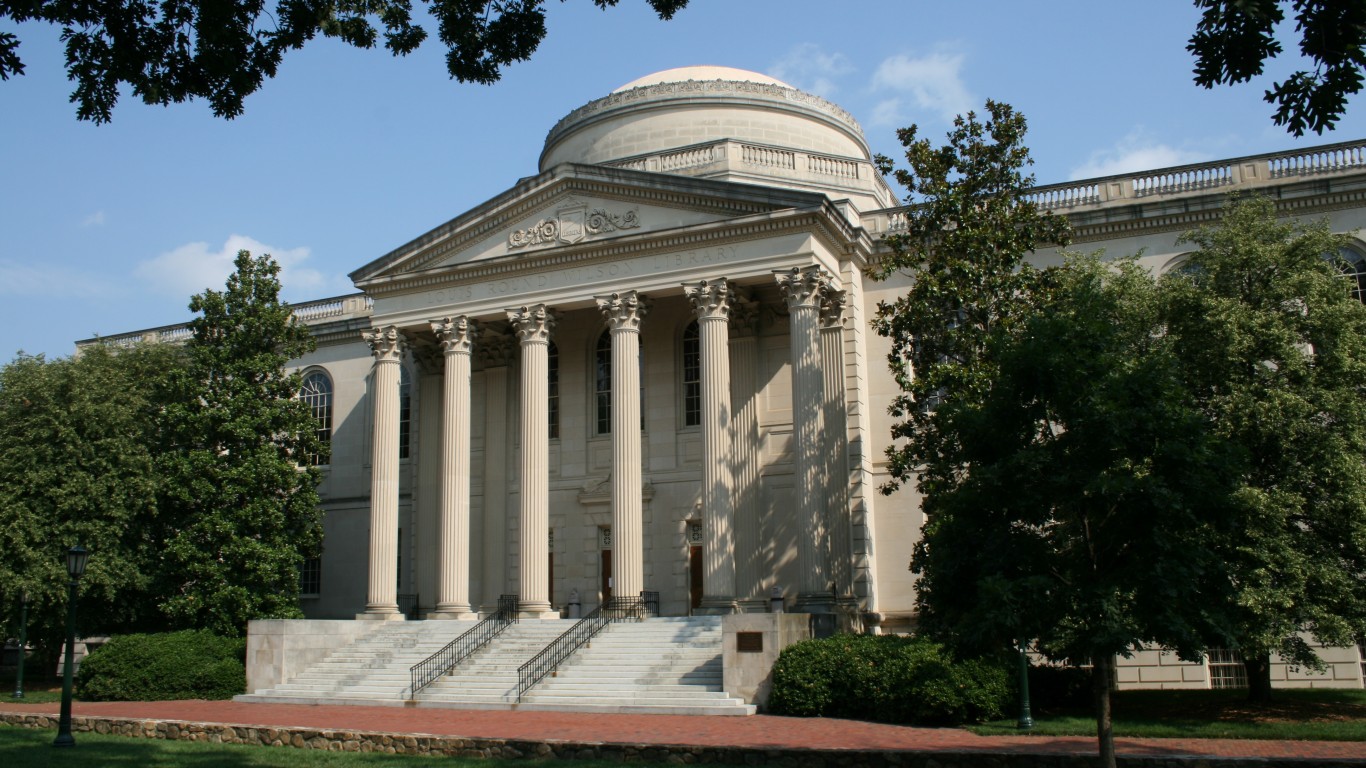
7. University of North Carolina at Chapel Hill
> Location: Chapel Hill, NC
> Undergraduate enrollment: 19,154
> Avg. net price: $10,085
> Admission rate: 22.6%
> Avg. earnings 10 years after entry: $68,800
Though the University of North Carolina at Chapel Hill offers A+-graded academics according to Niche, it is relatively inexpensive. Its average net price of just over $10,000 is the lowest among the nation’s top public universities and roughly in line with the typical public college nationwide.
Located in one corner of North Carolina’s Research Triangle, UNC is one of the nation’s top research universities. This is bolstered by the fact that the school has nearly $26,000 in research funding per student, compared to about $1,500 per student at the typical college.

6. University of California – Berkeley
> Location: Berkeley, CA
> Undergraduate enrollment: 31,348
> Avg. net price: $18,522
> Admission rate: 16.3%
> Avg. earnings 10 years after entry: $79,000
University of California – Berkeley is one of the six University of California System schools to rank among the nation’s top public universities. The school received A+ grades from Niche for its academics, diversity, and value.
Cal Berkeley is a well-known research institution — its alumni have won more than two dozen Nobel Prizes in medicine, chemistry, and physics. The school has more than $16,500 in research funding per student, which is more than 10 times higher than the funding at the typical college.
[in-text-ad]
5. United States Military Academy at West Point
> Location: West Point, NY
> Undergraduate enrollment: 4,457
> Avg. net price: N/A
> Admission rate: 12.0%
> Avg. earnings 10 years after entry: N/A
Though the United States Military Academy at West Point qualifies as a publicly funded university, it is very different from any school on this list. The Academy has strict criteria for admissions, as applicants must be an unmarried, childless U.S. citizen aged 17-22, meet rigorous physical, medical, and academic standards, and receive a nomination from certain service members or elected representatives, among other requirements.
West Point students, known as cadets, do not pay for their education and instead must serve eight years in the U.S. Army combined active duty and reserve. West Point offers a high-quality education, bolstered by its 7:1 student-to-faculty ratio.

4. University of Virginia
> Location: Charlottesville, VA
> Undergraduate enrollment: 17,010
> Avg. net price: $17,579
> Admission rate: 23.9%
> Avg. earnings 10 years after entry: $79,400
The University of Virginia is one of the most selective public schools in the country, admitting less than a quarter of its applicants. It is also one of just five public schools with a median combined SAT score of more than 1400. UVA students tend to go on to be financially successful, earning an average of over $79,000 a decade after entering college.
UVA is the only one of the top public schools in America at which liberal arts and sciences ranks as the most common major. At every other school on this list, the top major is either engineering, social sciences, business, or biological and biomedical sciences.
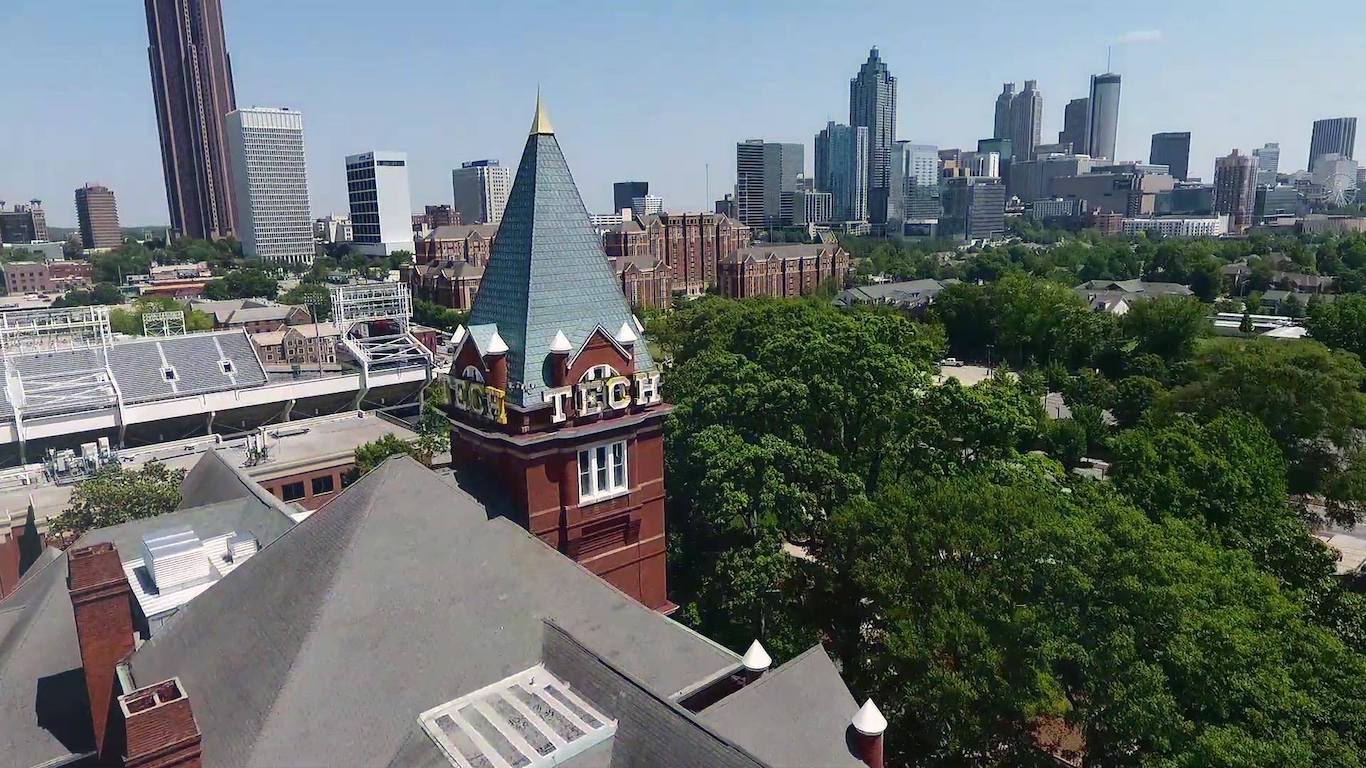
3. Georgia Institute of Technology
> Location: Atlanta, GA
> Undergraduate enrollment: 15,964
> Avg. net price: $16,883
> Admission rate: 20.6%
> Avg. earnings 10 years after entry: $85,900
Georgia Institute of Technology is one of the three top public universities in America, according to a Niche ranking. It received perfect A+ grades for its academics, diversity, and value.
As its name suggests, Georgia Tech excels in technology and other STEM fields. In fact, nearly 60% of all graduates earn degrees in engineering. These kinds of degrees set up students for financial success, as these job sectors tend to pay well. A decade after entering Georgia Tech, former students earn nearly $86,000 a year on average, one of the highest incomes of any public school. Those former students also have a 7.5% unemployment rate, one of the lowest percentages among public schools.
[in-text-ad-2]
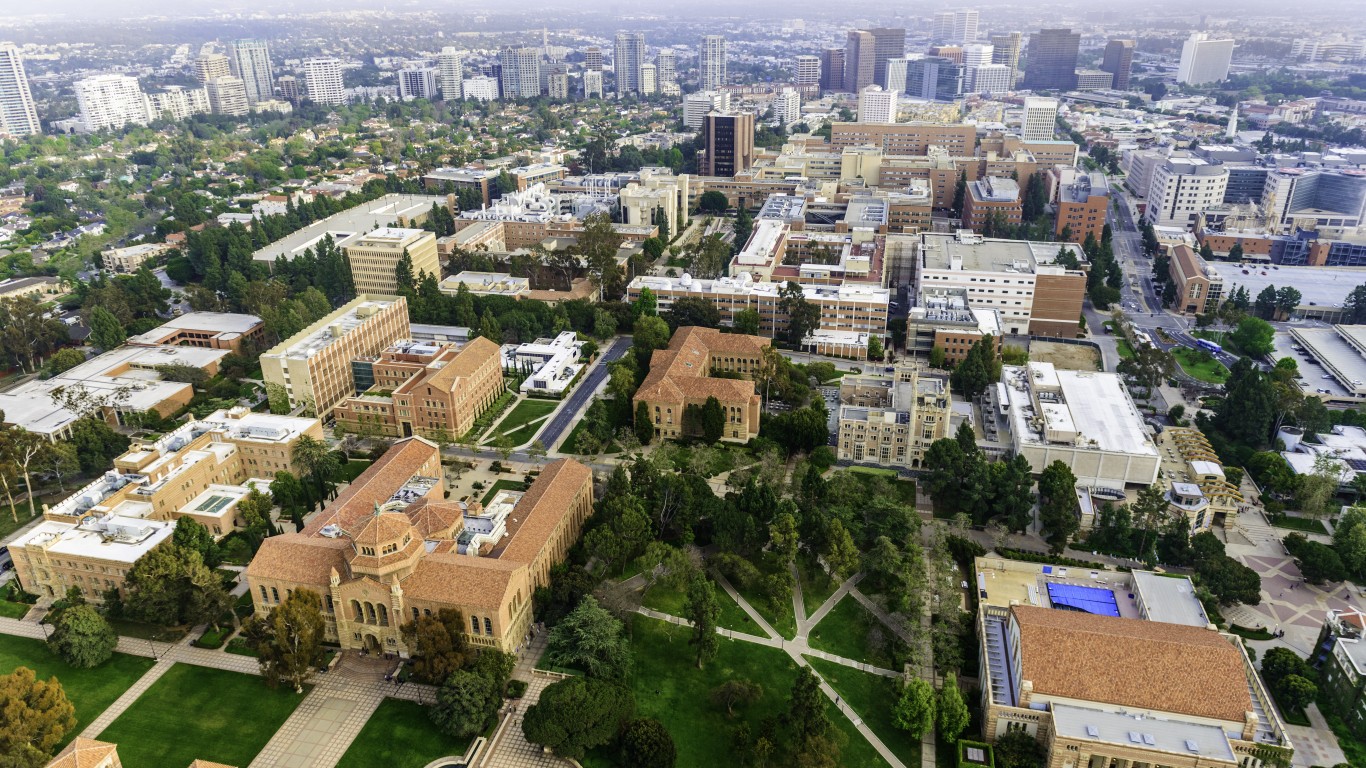
2. University of California – Los Angeles
> Location: Los Angeles, CA
> Undergraduate enrollment: 31,543
> Avg. net price: $15,718
> Admission rate: 12.3%
> Avg. earnings 10 years after entry: $73,200
The University of California – Los Angeles is one of America’s top public schools. It received A+ grades from Niche for its academics, athletics, diversity, campus, and value. The school’s professors are highly rated as well. The school attracts top professors by offering high pay. UCLA faculty earn an average of more than $171,000 a year, the highest of all public colleges nationwide.
Besides the U.S. Military Academy at West Point, no public school has a lower admission rate than UCLA, at 12.3%. The school received over 111,000 applications for the 2019-20 school year and admitted fewer than 14,000 students. Because of the high application volume, the school accepted only the top students and the median combined SAT score was 1405, one of the five highest in the nation among public colleges.
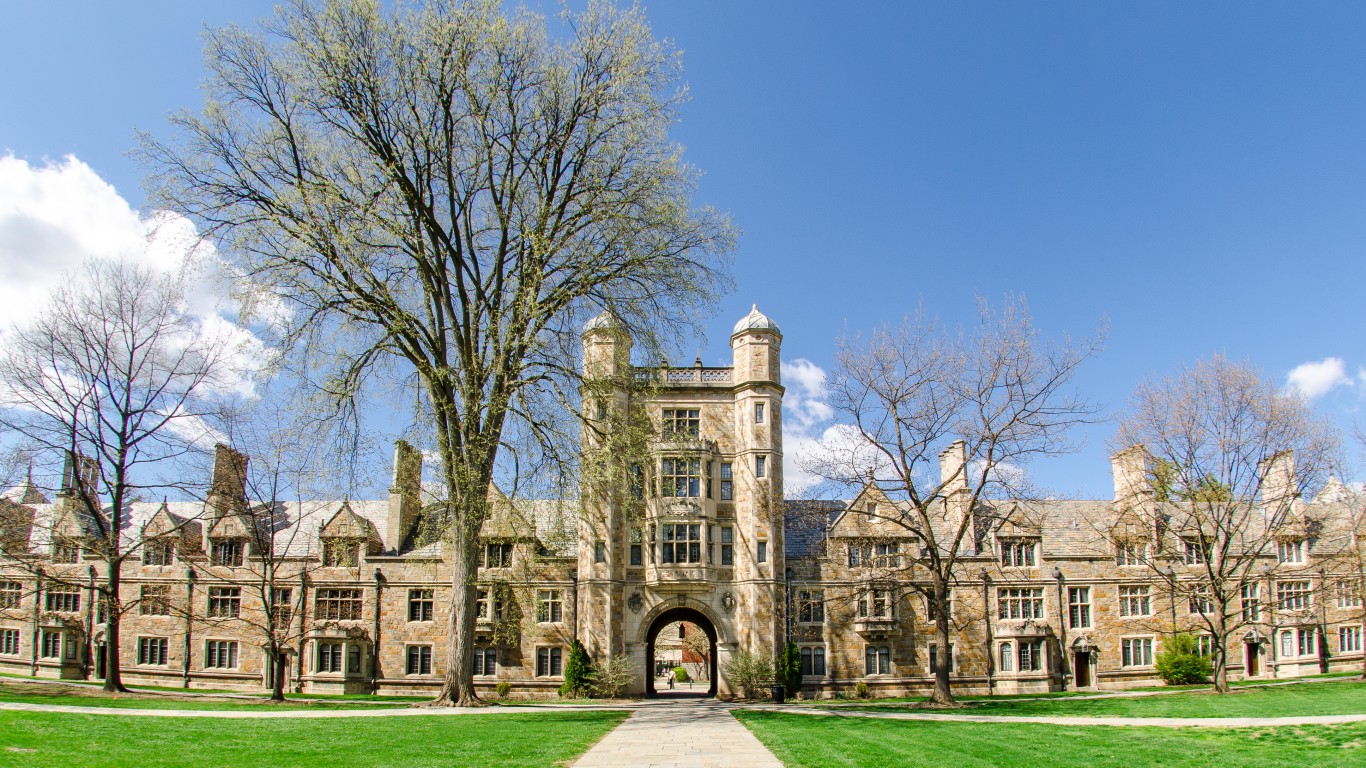
1. University of Michigan – Ann Arbor
> Location: Ann Arbor, MI
> Undergraduate enrollment: 31,266
> Avg. net price: $17,357
> Admission rate: 22.9%
> Avg. earnings 10 years after entry: $79,000
Because of its high ranking professors, value, academics, campus, and more, the University of Michigan – Ann Arbor ranks as the very best public university in America. With such a sterling reputation, the university can accept only the top students. Its 22.9% admissions rate is one of the lowest among public colleges, and its median combined SAT score of 1420 ranks third highest among all public colleges. Michigan’s 11:1 student-to-faculty ratio is among the lowest for public colleges, providing students more individualized attention, which tends to result in a better educational experience.
University of Michigan – Ann Arbor tends to set its students up for success. Average earnings among alumni students a decade after they enter college is $79,000, one of the 10 highest for all public schools. Though its average net price of over $17,000 is higher than most other American public colleges, its students receive earn an average of $21,174 in financial aid, the highest average for any public school.
Methodology
To determine the top public universities in America, 24/7 Wall St. reviewed data on academics, admissions, finance, and student life from school data platform Niche. We reviewed schools with a grade of A+ in Niche’s 2021 Top Public Universities in America report. Niche ranked only public four-year universities. Supplemental data on undergraduate enrollment as of fall 2019, average net price in the 2018-19 school year, the most common degree conferred during the 2017-18 academic year, and median earnings in 2015 of students who entered university in the and 2004-05 academic year came from the National Center for Education Statistics of the U.S. Department of Education.
Credit Card Companies Are Doing Something Nuts
Credit card companies are at war. The biggest issuers are handing out free rewards and benefits to win the best customers.
It’s possible to find cards paying unlimited 1.5%, 2%, and even more today. That’s free money for qualified borrowers, and the type of thing that would be crazy to pass up. Those rewards can add up to thousands of dollars every year in free money, and include other benefits as well.
We’ve assembled some of the best credit cards for users today. Don’t miss these offers because they won’t be this good forever.
Flywheel Publishing has partnered with CardRatings for our coverage of credit card products. Flywheel Publishing and CardRatings may receive a commission from card issuers.
Thank you for reading! Have some feedback for us?
Contact the 24/7 Wall St. editorial team.
 24/7 Wall St.
24/7 Wall St.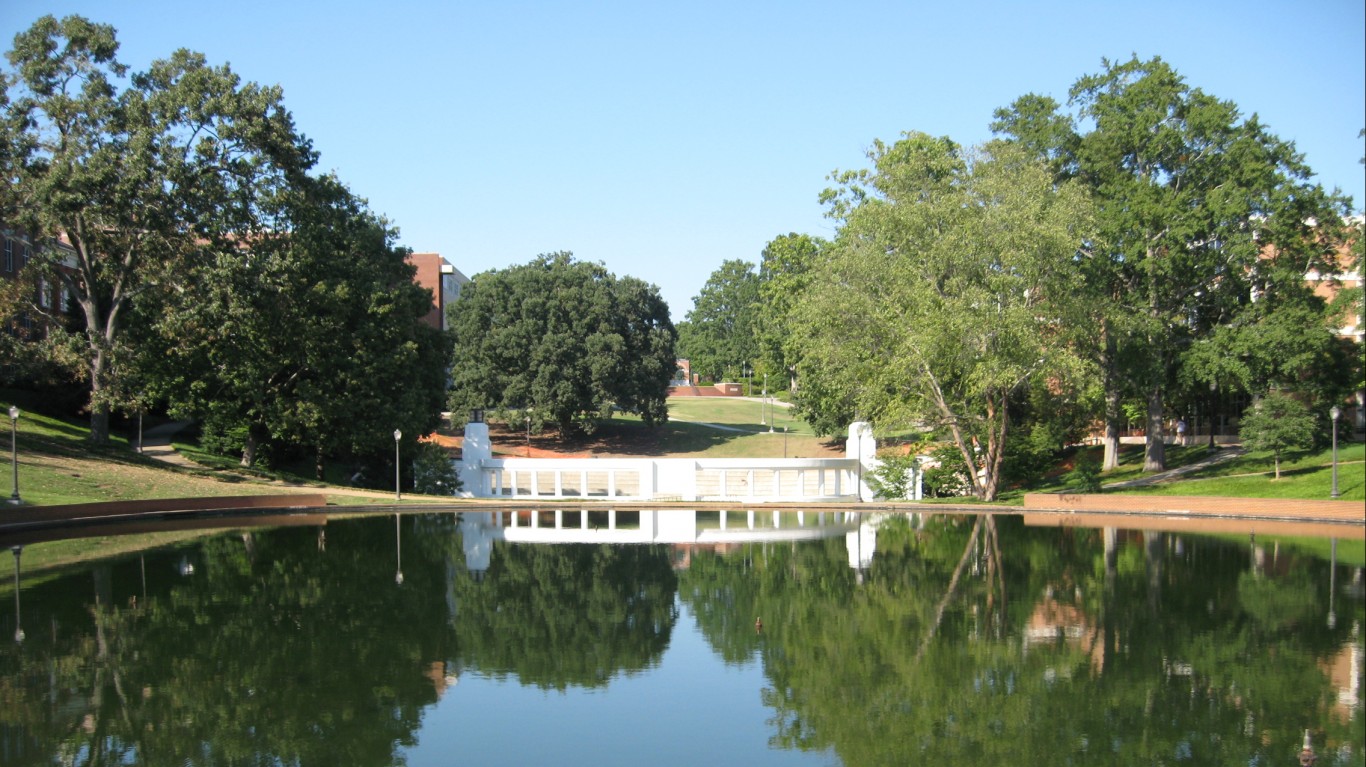

 24/7 Wall St.
24/7 Wall St.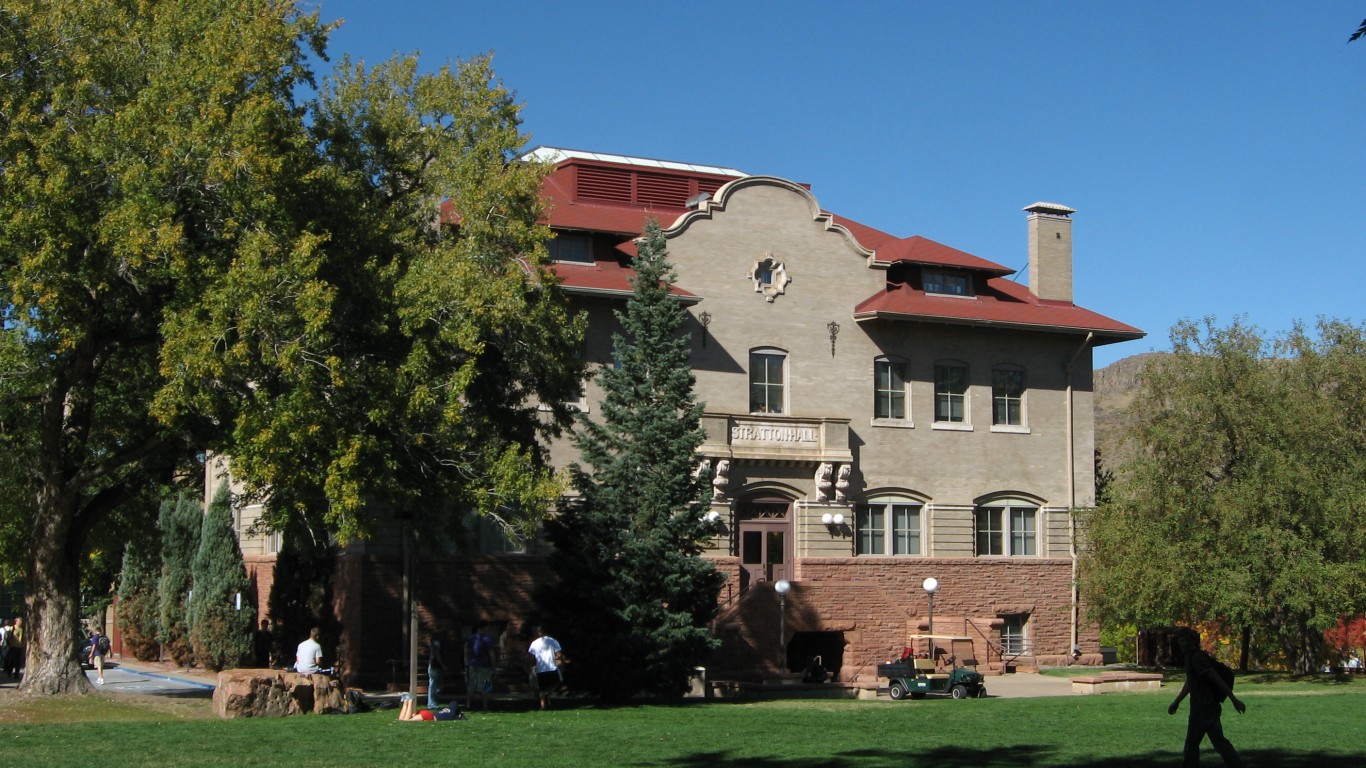
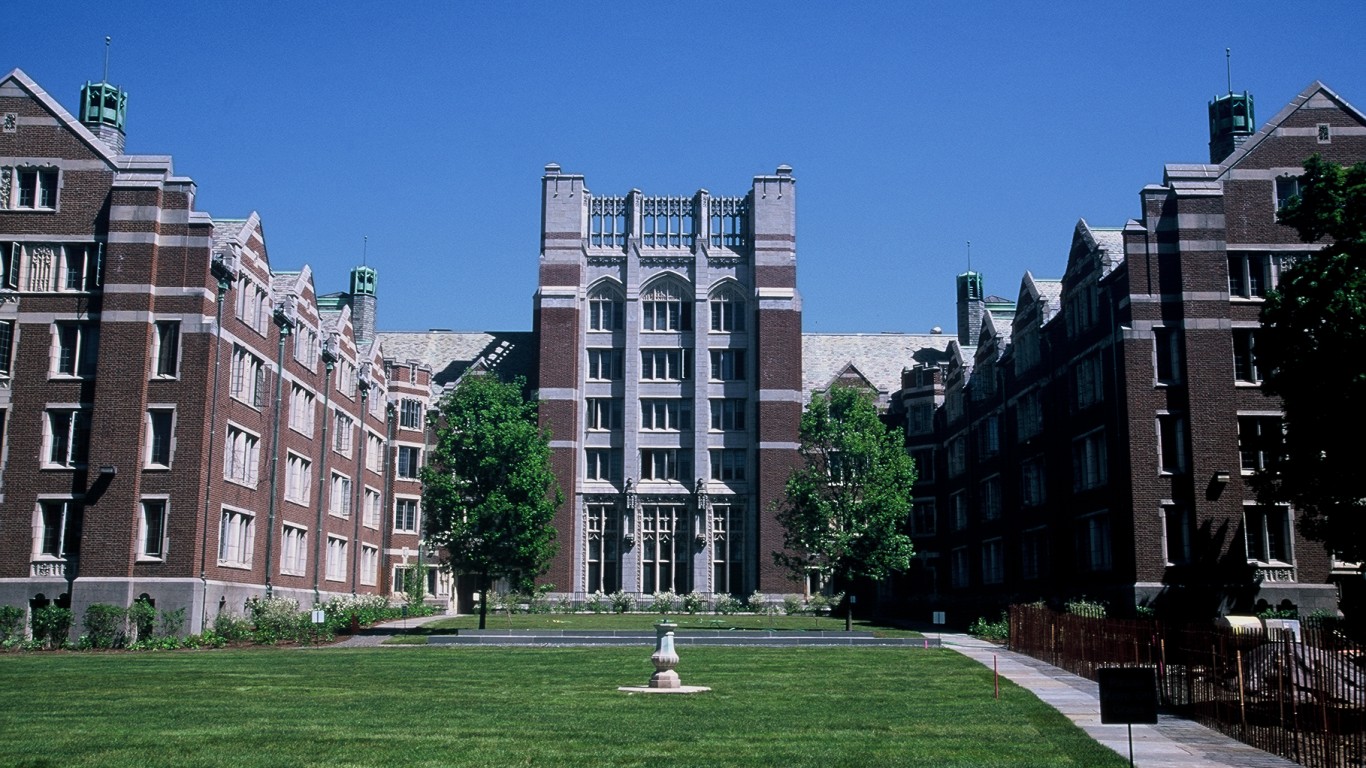 24/7 Wall St.
24/7 Wall St.